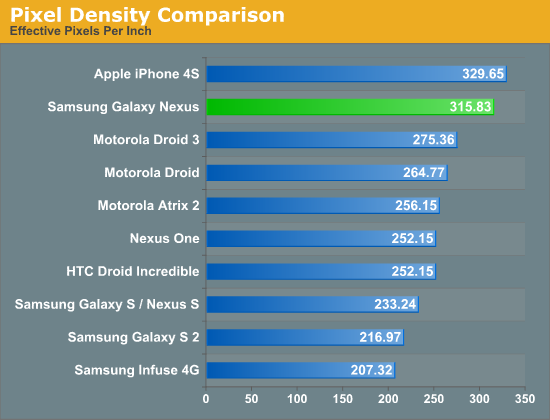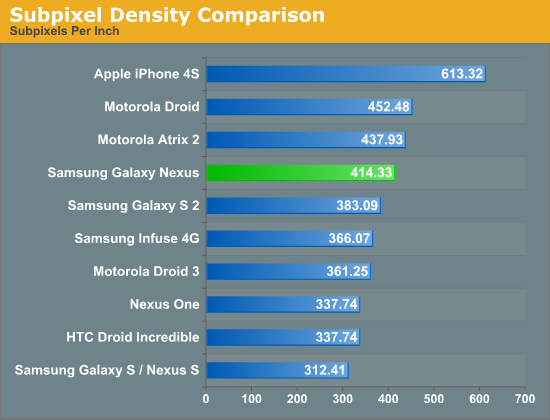Confirmed: Galaxy Nexus Includes PenTile
by Brian Klug & Jason Inofuentes on October 21, 2011 12:58 AM EST- Posted in
- Smartphones
- Samsung
- Ice Cream Sandwich
- Mobile
- AMOLED
- galaxy nexus
Though we've learned a lot about the Galaxy Nexus specifications already, one of the things that has remained a question thus far is whether its 4.65" 720p HD Super AMOLED display uses an RGB subpixel rendering layout or PenTile. We've now confirmed that the Galaxy Nexus display does in fact use RGBG PenTile, like all the Nexus devices to date. This isn't super surprising considering that Samsung has been pretty good about adhering to all the monikers it has gradually been tacking onto AMOLED. There are a number so far - 'super' connotes an optically bonded panel and digitizer stack, 'plus' connotes an RGB stripe, and now 'HD' connotes, well, 720p. HD Super AMOLED lacks Plus, and thus isn't an RGB stripe.
The next question is just what 4.65" HD Super AMOLED will look like, or whether the presence of PenTile will be as noticeable as previous AMOLED phones like the Nexus S / Galaxy S or Nexus One where it was arguably very noticeable. That said, at some subpixel density it should become difficult to impossible to notice PenTile's presence, it's just a matter of exceeding human visual acuity. Having not seen the Galaxy Nexus in person yet and given the absence of good macro shots of the display, we have put together a numerical comparison pitting the Galaxy Nexus panel up against some other common smartphone displays.
First up is a quick plot of the effective pixel density of some popular displays. Stated another way, this is the pixel density based on the manufacturer's stated logical resolution, which is also the resolution of Android's render target for the phone.

Note that this is the traditional means of reporting pixels per inch that we've published before. However, using this metric is just a bit misleading since it doesn't take into account the difference between 2 subpixel-per-pixel RGBG or RBGW PenTile versus the 3 subpixel-per-pixel RGB stripe. To make for an effective comparison, we've put together another plot where we take into account the presence of PenTile and report subpixel density.

Here things still look pretty good for the 4.65" HD Super AMOLED display, putting it just north of SGS2's Super AMOLED Plus display with an RGB stripe. I wager that if you were satisfied with the pixel density of SGS2 that the pixel density Galaxy Nexus actually won't be off-putting despite the presence of PenTile. In addition, hopefully some of the UI design considerations that come along with using PenTile (no vertical 1 pixel thick elements) have been taken into consideration from the outset for Ice Cream Sandwich. For true subjective impressions however, we'll have to wait and see.
Source: Data










152 Comments
View All Comments
marc1000 - Friday, October 21, 2011 - link
Brian, what about the N9 display? how does it stack up in this comparison?i've read somewhere that it uses a pentile grid too, but it is smaller than those 4.5" giants.... it's said to have a polarizer, wich is something i never saw on other phones, but that pentile "karma" made me kinda sad.
(and i've not had access to the phone yet to check if it actually looks good).
thanks in advance!
Jussi7 - Friday, October 21, 2011 - link
I can confirm the N9 screen uses pentile grid. For me the screen was the biggest letdown in the phone, text looked fuzzy and I could see the patterns in color fills that should have been solid. Also the brightness was much less than I expected. With sensory assessment the text was a tad sharper than on my iPhone 3GS, iPhone 4 was from another planet.If I did the math[1] correctly N9 screen would be at 429 sub pixels per inch.
[1] sqrt((480*3)^2 + 854^2) / 3.9
marc1000 - Friday, October 21, 2011 - link
thank you Jussi. i was looking for a confirmation if the text or solid colors really looks fuzzy on the N9. this was also a big letdown to me. i really liked the way meego works and the whole "button-less" experience...JasonInofuentes - Friday, October 21, 2011 - link
Ahh! You forgot, that's (480*2) not 3. You don't live in Philly do you? Disappointment or not, I'd love to play with an N9 for a little while.Jussi7 - Friday, October 21, 2011 - link
Yeah, I messed up the math, sorry about that. The new, hopefully better number is 329 sub pixels per inch.But the number does not really matter, the screen was disappointing. On the other hand the scrolling and transitions were very smooth. I mostly enjoyed the swipe based UI concept, although I kept doing some accidental swipes every now and then. I played with it just a few hours though, easily the best Nokia so far.
I do support the Eagles, and hate the Patriots, but no, I don't live in Philly. I currently reside in Helsinki, Finland. :)
luimana - Friday, October 21, 2011 - link
Hi Brian,I've followed the debate on how should the spi density be determined. I agree with your logic, but I come up with different numbers:
e.g iphone: 326ppi -> 3 sub pixel per pixel (only on one dimension) -> 326*sqrt(3)= 564,5spi
You used 329ppi in your graphs so you should obtain 569spi... How did you get 613?
Thanks
Luigi
JasonInofuentes - Friday, October 21, 2011 - link
The calculation is laid out in the discussions above but the equation we're using is explained nicely here (http://en.wikipedia.org/wiki/Pixel_density#Calcula... Essentially we're finding the diagonal resolution and then dividing that by the diagonal screen size. This is the mathematically right way to calculate pixel density. To calculate subpixel density you multiply the horizontal resolution (when in portrait!!) by the number of subpixels per pixel (2 for RGBG and three for RGB). Then calculate it out. For the iPhone 4:640 horizontal pixels X 3 subpixels/pixel = 1920 horizontal subpixels
diagonal subpixel resolution = SQRT (960^2 + 1920^2) = 2146.6 diagonal subpixels
subpixel density = diagonal subpixel resolution / diagonal screen size = 2146.6 / 3.5 = 613.3 ppi
Now, we did err in not using the finer screen size measurement of the iPhone that's used sometimes (3.54") but you'll forgive us ignoring those four hundredths of an inch, I'm sure.
marc1000 - Friday, October 21, 2011 - link
yeah i forgive you about those four hundredths of an inch of the iphone. and i used your step-by-step to calculate the pixel density based on the specs of Nokia N9.the number i came to: 329,45
wich seems pretty low in the graph... right next to HTC Droid. Is Droid's screen bad? or good?
my calculations:
480 horizontal pixels x 2 subpixels/pixel = 960 horizontal subpixels
diagonal subpixel resolution = SQRT (854^2 + 960^2) = 1284,87 diagonal subpixels
subpixel density = diagonal subpixel resolution / diagonal screen size = 1284,87 / 3,9 = 329,45 ppi
am i right?
JasonInofuentes - Friday, October 21, 2011 - link
The N9 is a great phone, but is compromised in it screen by being AMOLED, Pentile, and either a little too big or a little too small, depending on how you look at it. A little bigger and we could forgive it it's low resolution for being easier to type on (though I understand it's actually got a dreamy keyboard). A little smaller and it's density would be higher and it would satisfy a bit more.luimana - Friday, October 21, 2011 - link
Of course I forgive you (and hope you'll forgive me if I was so pedantic ;-) )Thanks for the clear explanation and the link.
Actually I happen to use a different formula which was equivalent to determine the ppi but actually not correct to determine the spi.
I'm always happy to learn something new, that's why I come and read Anandtech!